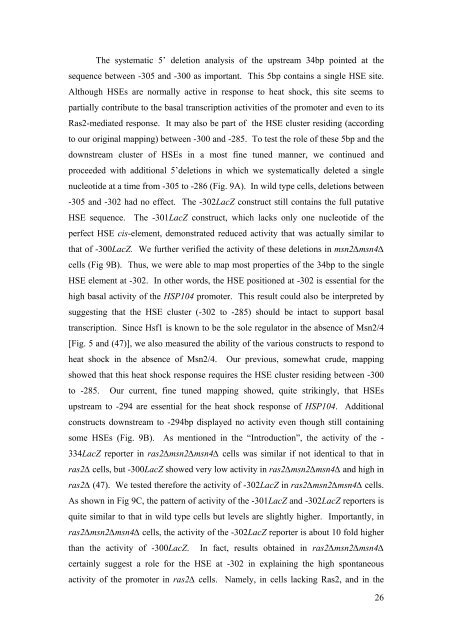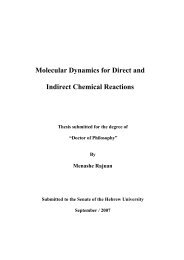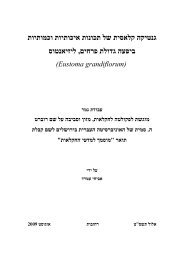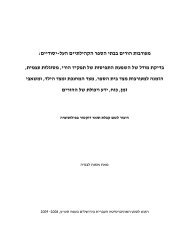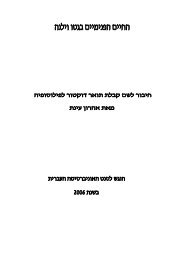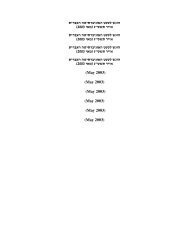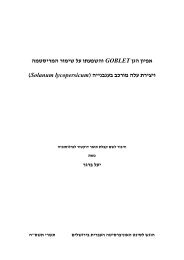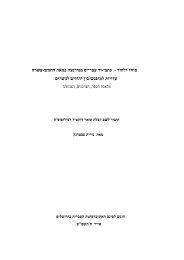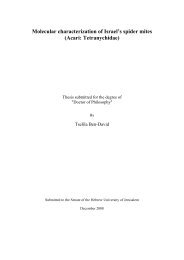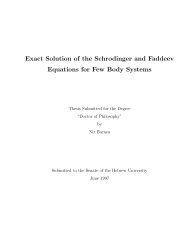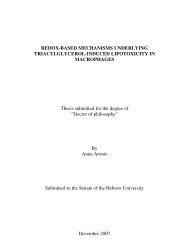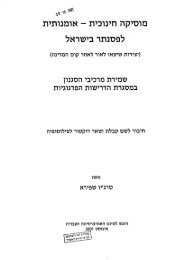Revealing the Mechanism of HSP104 Transcription Initiation in the ...
Revealing the Mechanism of HSP104 Transcription Initiation in the ...
Revealing the Mechanism of HSP104 Transcription Initiation in the ...
You also want an ePaper? Increase the reach of your titles
YUMPU automatically turns print PDFs into web optimized ePapers that Google loves.
The systematic 5’ deletion analysis <strong>of</strong> <strong>the</strong> upstream 34bp po<strong>in</strong>ted at <strong>the</strong><br />
sequence between -305 and -300 as important. This 5bp conta<strong>in</strong>s a s<strong>in</strong>gle HSE site.<br />
Although HSEs are normally active <strong>in</strong> response to heat shock, this site seems to<br />
partially contribute to <strong>the</strong> basal transcription activities <strong>of</strong> <strong>the</strong> promoter and even to its<br />
Ras2-mediated response. It may also be part <strong>of</strong> <strong>the</strong> HSE cluster resid<strong>in</strong>g (accord<strong>in</strong>g<br />
to our orig<strong>in</strong>al mapp<strong>in</strong>g) between -300 and -285. To test <strong>the</strong> role <strong>of</strong> <strong>the</strong>se 5bp and <strong>the</strong><br />
downstream cluster <strong>of</strong> HSEs <strong>in</strong> a most f<strong>in</strong>e tuned manner, we cont<strong>in</strong>ued and<br />
proceeded with additional 5’deletions <strong>in</strong> which we systematically deleted a s<strong>in</strong>gle<br />
nucleotide at a time from -305 to -286 (Fig. 9A). In wild type cells, deletions between<br />
-305 and -302 had no effect. The -302LacZ construct still conta<strong>in</strong>s <strong>the</strong> full putative<br />
HSE sequence. The -301LacZ construct, which lacks only one nucleotide <strong>of</strong> <strong>the</strong><br />
perfect HSE cis-element, demonstrated reduced activity that was actually similar to<br />
that <strong>of</strong> -300LacZ. We fur<strong>the</strong>r verified <strong>the</strong> activity <strong>of</strong> <strong>the</strong>se deletions <strong>in</strong> msn2∆msn4∆<br />
cells (Fig 9B). Thus, we were able to map most properties <strong>of</strong> <strong>the</strong> 34bp to <strong>the</strong> s<strong>in</strong>gle<br />
HSE element at -302. In o<strong>the</strong>r words, <strong>the</strong> HSE positioned at -302 is essential for <strong>the</strong><br />
high basal activity <strong>of</strong> <strong>the</strong> <strong>HSP104</strong> promoter. This result could also be <strong>in</strong>terpreted by<br />
suggest<strong>in</strong>g that <strong>the</strong> HSE cluster (-302 to -285) should be <strong>in</strong>tact to support basal<br />
transcription. S<strong>in</strong>ce Hsf1 is known to be <strong>the</strong> sole regulator <strong>in</strong> <strong>the</strong> absence <strong>of</strong> Msn2/4<br />
[Fig. 5 and (47)], we also measured <strong>the</strong> ability <strong>of</strong> <strong>the</strong> various constructs to respond to<br />
heat shock <strong>in</strong> <strong>the</strong> absence <strong>of</strong> Msn2/4. Our previous, somewhat crude, mapp<strong>in</strong>g<br />
showed that this heat shock response requires <strong>the</strong> HSE cluster resid<strong>in</strong>g between -300<br />
to -285. Our current, f<strong>in</strong>e tuned mapp<strong>in</strong>g showed, quite strik<strong>in</strong>gly, that HSEs<br />
upstream to -294 are essential for <strong>the</strong> heat shock response <strong>of</strong> <strong>HSP104</strong>. Additional<br />
constructs downstream to -294bp displayed no activity even though still conta<strong>in</strong><strong>in</strong>g<br />
some HSEs (Fig. 9B). As mentioned <strong>in</strong> <strong>the</strong> “Introduction”, <strong>the</strong> activity <strong>of</strong> <strong>the</strong> -<br />
334LacZ reporter <strong>in</strong> ras2∆msn2∆msn4∆ cells was similar if not identical to that <strong>in</strong><br />
ras2∆ cells, but -300LacZ showed very low activity <strong>in</strong> ras2∆msn2∆msn4∆ and high <strong>in</strong><br />
ras2∆ (47). We tested <strong>the</strong>refore <strong>the</strong> activity <strong>of</strong> -302LacZ <strong>in</strong> ras2∆msn2∆msn4∆ cells.<br />
As shown <strong>in</strong> Fig 9C, <strong>the</strong> pattern <strong>of</strong> activity <strong>of</strong> <strong>the</strong> -301LacZ and -302LacZ reporters is<br />
quite similar to that <strong>in</strong> wild type cells but levels are slightly higher. Importantly, <strong>in</strong><br />
ras2∆msn2∆msn4∆ cells, <strong>the</strong> activity <strong>of</strong> <strong>the</strong> -302LacZ reporter is about 10 fold higher<br />
than <strong>the</strong> activity <strong>of</strong> -300LacZ. In fact, results obta<strong>in</strong>ed <strong>in</strong> ras2∆msn2∆msn4∆<br />
certa<strong>in</strong>ly suggest a role for <strong>the</strong> HSE at -302 <strong>in</strong> expla<strong>in</strong><strong>in</strong>g <strong>the</strong> high spontaneous<br />
activity <strong>of</strong> <strong>the</strong> promoter <strong>in</strong> ras2∆ cells. Namely, <strong>in</strong> cells lack<strong>in</strong>g Ras2, and <strong>in</strong> <strong>the</strong><br />
26


